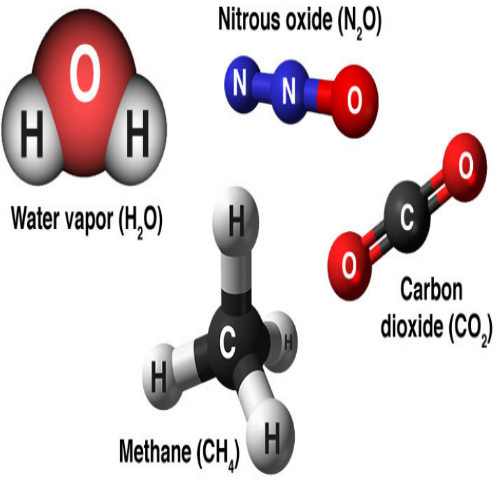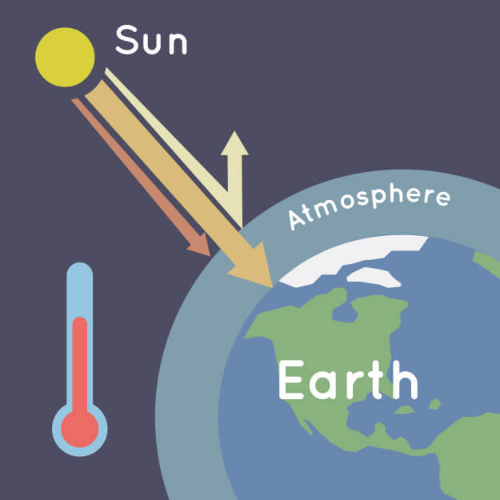WHAT IS GHG?
Green House Gas or GHG gives rise to the greenhouse effect. It is a natural phenomenon that has been occurring on the Earth for millennia. It is a natural process that ensures that our Earth has the perfect ‘liveable’ conditions to sustain life. The greenhouse effect occurs as gases in the Earth’s atmosphere trap heat within the atmosphere that is radiating out from the Earth. This radiation is being bounced off the Earth from the incoming rays from the sun.
Read More
What are examples of greenhouse gases?
These gases include:
- Carbon dioxide (CO2)
- Water vapour (H2O)
- Methane (CH4)
- Ozone (O3)
The contributions of these gases to the greenhouse effect are approximately as follows:
- Carbon dioxide – 9 to 26%
- Water vapour (not including clouds) – 36 to 70%
- Methane – 4 to 9%
- Ozone – 3 to 7%.
There are also other gases that act as greenhouse gases, though they are found in much lower concentrations in the atmosphere. These include:
- Nitrous oxide (N2O)
- Sulphur hexafluoride (SF6)
- Hydrofluorocarbons (HFC’s)
- Perfluorocarbons (PFC’s)
- Chlorofluorocarbons (CFCs)
How do the greenhouse gases contribute to warming of the atmosphere?
Greenhouse gases act like a blanket, making the Earth, on average, about 15 degrees Celsius warmer that it would otherwise be. Much colder average temperatures would mean life could not survive on our planet.
How strong are the different gases?
- Water vapour is the most powerful greenhouse gas (because it can absorb the most heat), however it does not remain longer than a few days in the atmosphere.
- Methane, if not burnt, is also more potent than carbon dioxide in terms of its ability to hold heat. It can persist in the atmosphere for about a decade. However, the most dangerous greenhouse gas in the long term is carbon dioxide itself… this is because it can endure in the atmosphere for much longer than water vapour or methane. Carbon dioxide remains much longer, from thousands to hundreds of thousands of years.
- Nitrous oxide is about 300 times more potent than carbon dioxide, and it can last in the atmosphere for about 100 years.
- Hydrofluorocarbons have one of their hydrogen atoms replaced by fluorine. They do not damage the ozone layer, but they do act as potent greenhouse gases. In fact, they can be very potent, because they absorb radiation and they can live in the atmosphere for a relatively long time (about 15 years). HFC’s are used in air conditioning. Some of the most popular ones can be about 150 to 5000 times more potent than carbon dioxide.
- Perfluorocarbons (containing carbon and fluorine only) are also potent greenhouse gases, with some being about 7000 to 11 700 times more potent than carbon dioxide. They can last a very long time in the atmosphere; some estimates are at 50 000 years!
- Sulphur hexafluoride (which was used as an insulator in electrical, heating and freezing purposes is by far and away the most potent greenhouse gas. It is about 24 000 times more potent than carbon dioxide. For this reason, its use has been banned around the world.
What is the difference between the greenhouse effect and global warming?
The greenhouse effect is the natural process that occurs on the Earth in order to keep the atmosphere warm. It has been happening since the early days of Earth’s life. The greenhouse effect has made life on Earth possible – we have the perfect concentrations of oxygen and carbon dioxide to encourage plant growth and animal respiration. It also means the Earth is neither too cold nor too hot to survive.
Global warming is an increase in average annual temperatures around the world. Scientists have been searching for evidence or clues as to what the Earth’s climate has been like, looking back over the past 800 000 years or so. This is usually done by carbon dating the bubbles of air trapped deep in the Earth’s deepest ice cores in polar regions (which have preserved life, just like your freezer!). They have done this because of the known link between carbon dioxide concentrations in the atmosphere and its role as a greenhouse gas – with more carbon dioxide meaning warmer temperatures. There is evidence that suggests that the Earth has gone through many cycles of warmer and cooler periods (called glacial retreat, ice age etc.). Generally, these variations are due to slight changes in the Earth’s orbit and the solar radiation it received. However, looking back over these millennia, carbon dioxide concentrations have never been as high as they are now. Currently, concentrations are at about 430 parts per million (rising from 300 parts per million in the 1950’s), whereas over the past 700 000 or 800 000 years, they have always been below 300 parts per million. Since carbon dioxide is the most potent greenhouse gas, we can deduct that these record high concentrations will and are contributing to an enhanced greenhouse effect, significant global warming, and ultimately to noticeable global climate change.
Read Less




WHAT IS GHG?




Green House Gas or GHG gives rise to the greenhouse effect. It is a natural phenomenon that has been occurring on the Earth for millennia. It is a natural process that ensures that our Earth has the perfect ‘liveable’ conditions to sustain life. The greenhouse effect occurs as gases in the Earth’s atmosphere trap heat within the atmosphere that is radiating out from the Earth. This radiation is being bounced off the Earth from the incoming rays from the sun.
Read More
What are examples of greenhouse gases?
These gases include:
- Carbon dioxide (CO2)
- Water vapour (H2O)
- Methane (CH4)
- Ozone (O3)
The contributions of these gases to the greenhouse effect are approximately as follows:
- Carbon dioxide – 9 to 26%
- Water vapour (not including clouds) – 36 to 70%
- Methane – 4 to 9%
- Ozone – 3 to 7%.
There are also other gases that act as greenhouse gases, though they are found in much lower concentrations in the atmosphere. These include:
- Nitrous oxide (N2O)
- Sulphur hexafluoride (SF6)
- Hydrofluorocarbons (HFC’s)
- Perfluorocarbons (PFC’s)
- Chlorofluorocarbons (CFCs)
How do the greenhouse gases contribute to warming of the atmosphere?
Greenhouse gases act like a blanket, making the Earth, on average, about 15 degrees Celsius warmer that it would otherwise be. Much colder average temperatures would mean life could not survive on our planet.
How strong are the different gases?
- Water vapour is the most powerful greenhouse gas (because it can absorb the most heat), however it does not remain longer than a few days in the atmosphere.
- Methane, if not burnt, is also more potent than carbon dioxide in terms of its ability to hold heat. It can persist in the atmosphere for about a decade. However, the most dangerous greenhouse gas in the long term is carbon dioxide itself… this is because it can endure in the atmosphere for much longer than water vapour or methane. Carbon dioxide remains much longer, from thousands to hundreds of thousands of years.
- Nitrous oxide is about 300 times more potent than carbon dioxide, and it can last in the atmosphere for about 100 years.
- Hydrofluorocarbons have one of their hydrogen atoms replaced by fluorine. They do not damage the ozone layer, but they do act as potent greenhouse gases. In fact, they can be very potent, because they absorb radiation and they can live in the atmosphere for a relatively long time (about 15 years). HFC’s are used in air conditioning. Some of the most popular ones can be about 150 to 5000 times more potent than carbon dioxide.
- Perfluorocarbons (containing carbon and fluorine only) are also potent greenhouse gases, with some being about 7000 to 11 700 times more potent than carbon dioxide. They can last a very long time in the atmosphere; some estimates are at 50 000 years!
- Sulphur hexafluoride (which was used as an insulator in electrical, heating and freezing purposes is by far and away the most potent greenhouse gas. It is about 24 000 times more potent than carbon dioxide. For this reason, its use has been banned around the world.
What is the difference between the greenhouse effect and global warming?
The greenhouse effect is the natural process that occurs on the Earth in order to keep the atmosphere warm. It has been happening since the early days of Earth’s life. The greenhouse effect has made life on Earth possible – we have the perfect concentrations of oxygen and carbon dioxide to encourage plant growth and animal respiration. It also means the Earth is neither too cold nor too hot to survive.
Global warming is an increase in average annual temperatures around the world. Scientists have been searching for evidence or clues as to what the Earth’s climate has been like, looking back over the past 800 000 years or so. This is usually done by carbon dating the bubbles of air trapped deep in the Earth’s deepest ice cores in polar regions (which have preserved life, just like your freezer!). They have done this because of the known link between carbon dioxide concentrations in the atmosphere and its role as a greenhouse gas – with more carbon dioxide meaning warmer temperatures. There is evidence that suggests that the Earth has gone through many cycles of warmer and cooler periods (called glacial retreat, ice age etc.). Generally, these variations are due to slight changes in the Earth’s orbit and the solar radiation it received. However, looking back over these millennia, carbon dioxide concentrations have never been as high as they are now. Currently, concentrations are at about 430 parts per million (rising from 300 parts per million in the 1950’s), whereas over the past 700 000 or 800 000 years, they have always been below 300 parts per million. Since carbon dioxide is the most potent greenhouse gas, we can deduct that these record high concentrations will and are contributing to an enhanced greenhouse effect, significant global warming, and ultimately to noticeable global climate change.
Read Less

Carbon Offset Advisory acknowledges the traditional owners and custodians of country throughout Australia and acknowledges their continuing connection to land, water and community.
We pay our respects to the people, the cultures and the elders past, present and emerging.

